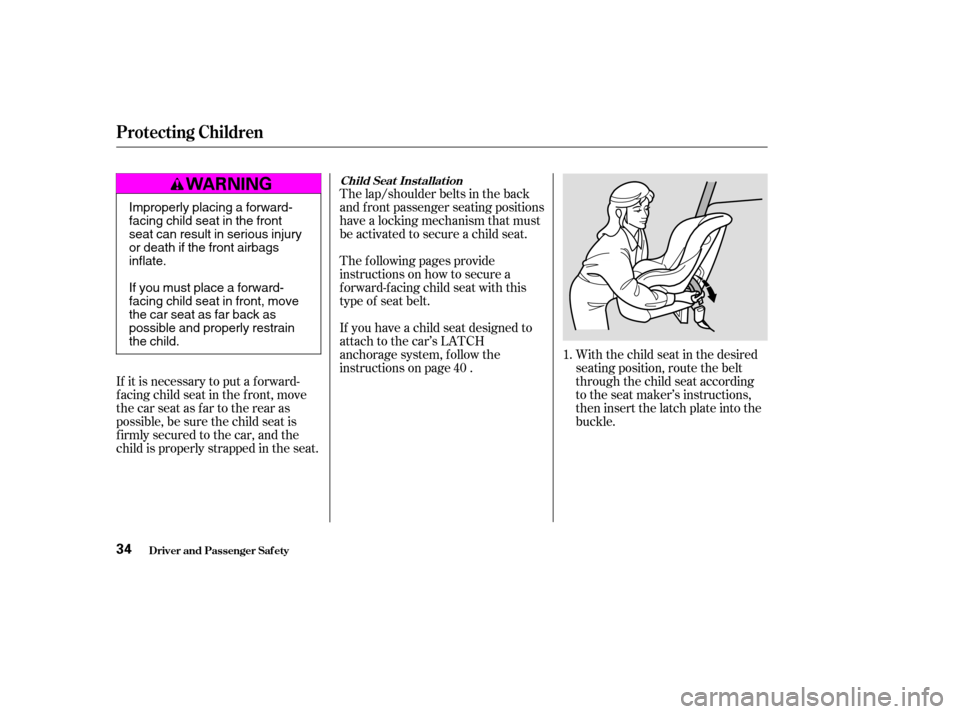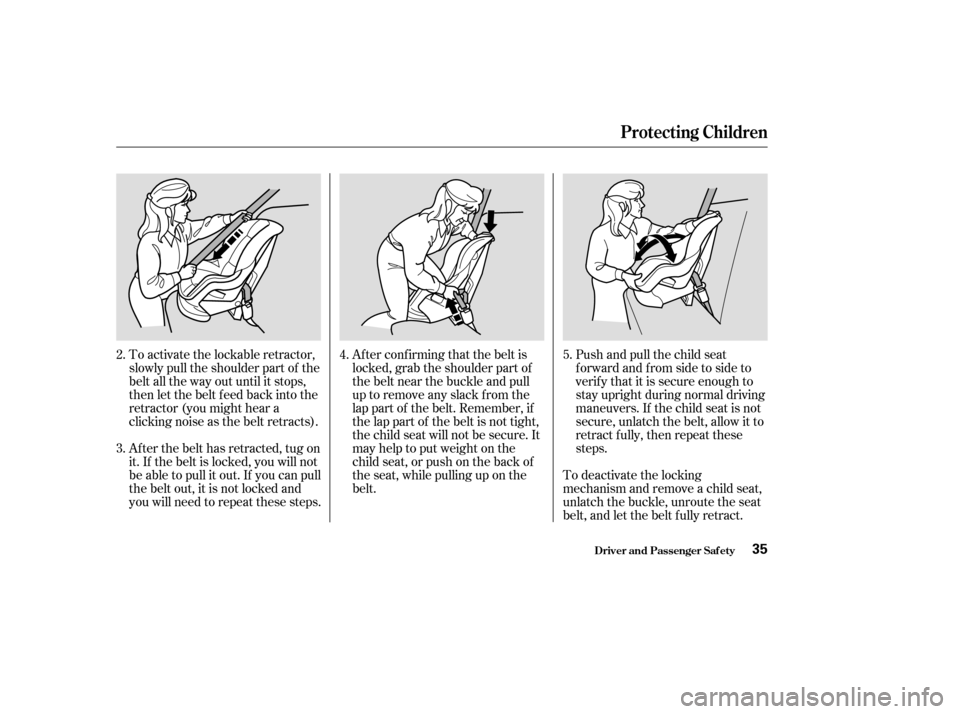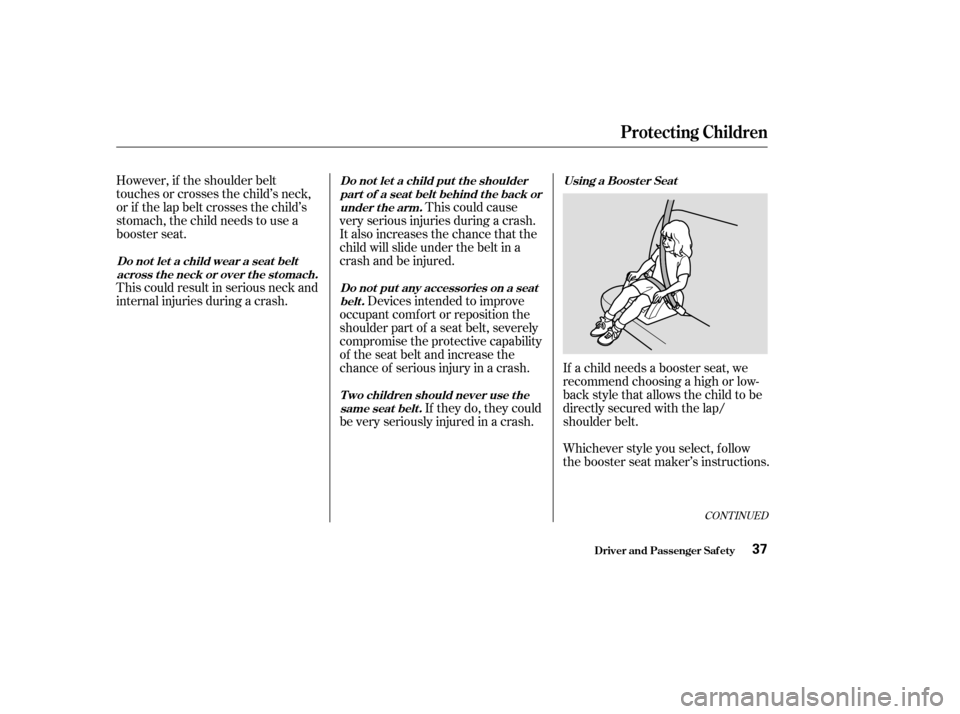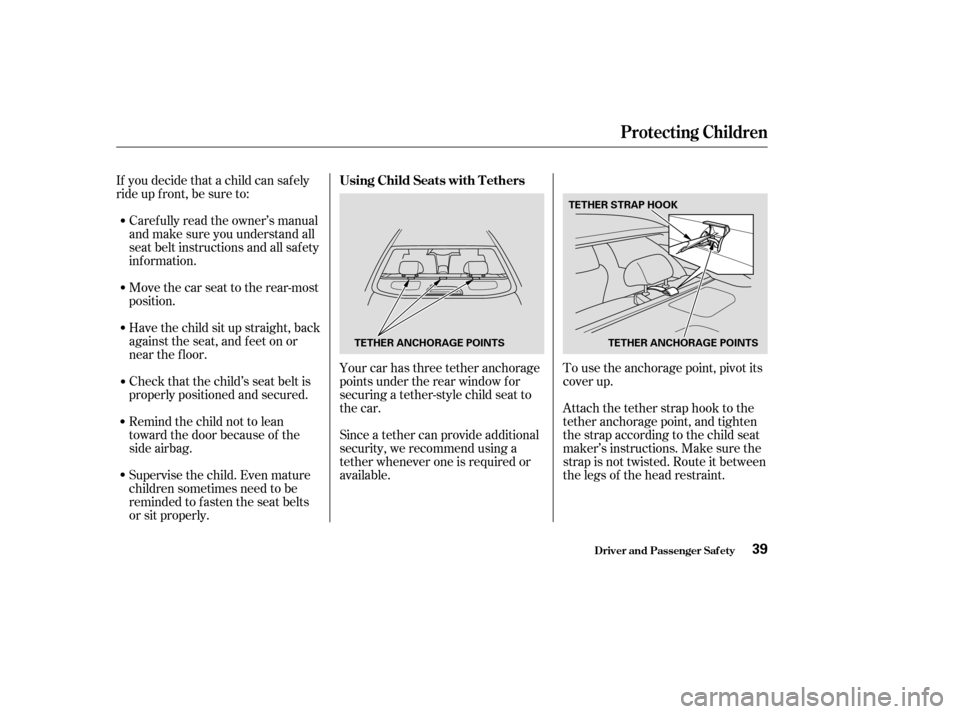Page 32 of 380

The lap/shoulder belts in the back
and f ront passenger seating positions
have a locking mechanism that must
be activated to secure a child seat.With the child seat in the desired
seating position, route the belt
through the child seat according
to the seat maker’s instructions,
then insert the latch plate into the
buckle.
The f ollowing pages provide
instructions on how to secure a
f orward-f acing child seat with this
type of seat belt.
If it is necessary to put a f orward-
f acing child seat in the f ront, move
the car seat as far to the rear as
possible, be sure the child seat is
f irmly secured to the car, and the
child is properly strapped in the seat. If you have a child seat designed to
attach to the car’s LATCH
anchorage system, follow the
instructions on page .
1.
40
Child Seat Inst allat ion
Protecting Children
Driver and Passenger Saf ety34
Improperly placing a forward-
facing child seat in the front
seat can result in serious injury
or death if the front airbagsinflate.
Ifyoumustplaceaforward-
facing child seat in front, move
the car seat as far back as
possible and properly restrain
the child.
�����—�����—�����y���
�������
���y���
�(�����������y���������y
Page 33 of 380

To activate the lockable retractor,
slowly pull the shoulder part of the
belt all the way out until it stops,
then let the belt f eed back into the
retractor (you might hear a
clicking noise as the belt retracts).
Af ter the belt has retracted, tug on
it. If the belt is locked, you will not
be able to pull it out. If you can pull
the belt out, it is not locked and
you will need to repeat these steps.Af ter conf irming that the belt is
locked, grab the shoulder part of
the belt near the buckle and pull
up to remove any slack from the
lap part of the belt. Remember, if
the lap part of the belt is not tight,
the child seat will not be secure. It
mayhelptoputweightonthe
child seat, or push on the back of
the seat, while pulling up on the
belt.
Push and pull the child seat
f orward and f rom side to side to
verif y that it is secure enough to
stay upright during normal driving
maneuvers. If the child seat is not
secure, unlatch the belt, allow it to
retract f ully, then repeat these
steps.
To deactivate the locking
mechanism and remove a child seat,
unlatch the buckle, unroute the seat
belt, and let the belt f ully retract.
2. 3.
4.
5.
Protecting Children
Driver and Passenger Saf ety35
�����—�����—�����y���
�����������y���
�(�����������y���������y
Page 35 of 380

CONT INUED
Whichever style you select, f ollow
the booster seat maker’s instructions.
However, if the shoulder belt
touchesorcrossesthechild’sneck,
or if the lap belt crosses the child’s
stomach, the child needs to use a
booster seat.
This could cause
very serious injuries during a crash.
It also increases the chance that the
child will slide under the belt in a
crash and be injured.
Devices intended to improve
occupant comf ort or reposition the
shoulder part of a seat belt, severely
compromise the protective capability
of the seat belt and increase the
chance of serious injury in a crash.
If they do, they could
be very seriously injured in a crash. If a child needs a booster seat, we
recommend choosing a high or low-
back style that allows the child to be
directly secured with the lap/
shoulder belt.
This could result in serious neck and
internal injuries during a crash.
Protecting Children
Driver and Passenger Saf ety
Using a Boost er Seat
Do not let a child put the shoulder
part of a seat belt behind t he back orunder t he arm.
Do not put any accessories on a seatbelt.
T wo children should never use t hesame seat belt .
Do not let a child wear a seat belt
across t he neck or over t he st omach.
37
�����—�����—�����y���
�����������y���
�(�����������y���������y
Page 37 of 380

If you decide that a child can saf ely
ride up f ront, be sure to:Caref ully read the owner’s manual
and make sure you understand all
seat belt instructions and all saf ety
inf ormation.
Have the child sit up straight, back
against the seat, and feet on or
near the f loor.
Move the car seat to the rear-most
position.
Remind the child not to lean
toward the door because of the
side airbag.
Check that the child’s seat belt is
properly positioned and secured.
Supervise the child. Even mature
children sometimes need to be
reminded to f asten the seat belts
or sit properly. Your car has three tether anchorage
points under the rear window f or
securing a tether-style child seat to
the car.
Since a tether can provide additional
security, we recommend using a
tether whenever one is required or
available.
To use the anchorage point, pivot its
cover up.
Attach the tether strap hook to the
tether anchorage point, and tighten
the strap according to the child seat
maker’s instructions. Make sure the
strap is not twisted. Route it between
the legs of the head restraint.
Protecting Children
Driver and Passenger Saf ety
Using Child Seats with T ethers
39
TETHER STRAP HOOK
TETHER ANCHORAGE P OINTS
TETHER ANCHORAGE P OINTS
�����—�����—�����y�
����
����
���y���
�(�����������y���������y
Page 38 of 380
Your car is equipped with LATCH
(Lower Anchors and Tethers f or
Children) at the outer rear seats.
The lower anchors are located
between the seat-back and seat
bottom and are to be used only with
a child seat designed f or use with
LATCH.
The exact location of each lower
anchor is marked with a small button
above the lower anchor point.To install a LATCH-compatible child
seat:
Move the seat belt buckle or
center seat belt away from the
lower anchor.
Make sure there are no f oreign
objects around the anchors.
Foreign objects could get in the
way of a secure connection
between the child seat and the
anchors. Put the child seat in the rear lef t
or right car seat, and attach the
child seat to the lower anchors
according to the child seat maker’s
instructions.
1. 2.
3.
Protecting Children
Driver and Passenger Saf ety
Using L A T CH
40
LOWERANCHORMARKS Rigid type
�����—�����—�����y�
����
��������y���
�(�����������y���������y
Page 39 of 380
Follow the child seat maker’s
instructions f or any additional
advice on adjusting or tightening
the fit.Attach the tether strap hook to the
tether anchorage point, and
tighten the strap according to the
child seat maker’s instructions.
Make sure the strap is not twisted.
Route it between the legs of the
head restraint.
Push and pull the child seat
f orward and f rom side to side to
verif y that it is secure enough to
stay upright during normal driving
maneuvers.This symbol on rear or f orward
f acing child seats or booster
cushions indicates the presence of
LATCH compatible hardware.
4.
5. 6.
Protecting Children
Driver and Passenger Saf ety
L ower Universal Anchorage
System Symbol
41
Flexible typeTETHER STRAP HOOK
TETHER ANCHORAGE P OINTS
�����—�����—�����y�
����
��������y���
�(�����������y���������y
Page 40 of 380

This seat belt has a single belt that
goes over your shoulder, across your
chest and across your hips. The seat belts in all seating positionsexcept the driver’s have an additional
locking mechanism that must be
activated to secure a child seat. (See
pages and f or instructions on
how to secure child seats with this
type of seat belt.)
All seat belts have an emergency
locking retractor. In normal driving,
the retractor lets you move f reely in
your seat while it keeps some
tension on the belt. During a collision
or sudden stop, the retractor
automatically locks the belt to help
restrain your body.
Guide the belt across your body to
the door pillar. Af ter exiting the car,
be sure the belt is out of the way and
will not get closed in the door.
To unlock the belt, push the red
PRESSbuttononthebuckle.
To fasten the belt, insert the latch
plate into the buckle, then tug on the
belt to make sure the buckle is
latched.
Your seat belt system includes lap/
shoulder belts in all f ive seating
positions. The f ront seat belts are
also equipped with automatic seat
belt tensioners.
The seat belt system also
includes a light on the
instrument panel to remind you and
your passengers to f asten your belts.
If the driver’s seat belt is not
fastened before the ignition is turned
ON (II), the light will come on and a
beeper will also sound. The beeper
will stop af ter a f ew seconds, but the
light will stay on until the driver’s
seat belt is f astened.
31 34
Seat Belt System Components L ap/Shoulder Belt
Additional Inf ormation About Your Seat Belts
Driver and Passenger Saf ety42
�����—�����—�����y���
�����������y���
�(�����������y���������y
Page 54 of 380
The U.S. instrument panel is shown. Dif f erences f or the Canadian models are noted in thetext.
Indicator L ights
Inst rument s and Cont rols57
CRUISE CONTROL INDICATOR
LOW FUEL INDICATOR LIGHT ON INDICATOR
SEAT BELT REMINDER LIGHT MAINTENANCE REQUIRED
INDICATOR
HIGH BEAM INDICATOR
MALFUNCTION
INDICATOR LAMP TRACTION CONTROL SYSTEM
INDICATOR
CRUISE MAIN INDICATOR ANTI-LOCK BRAKE SYSTEM
INDICATOR
PARKING BRAKE AND BRAKE
SYSTEM INDICATOR TCS ACTIVATION INDICATOR
LOW OIL PRESSURE
INDICATOR (P.58)
CHARGING SYSTEM
INDICATOR (P.62)
(P.62)
DOOR MONITOR
SECURITY SYSTEM INDICATOR SUPPLEMENTAL
RESTRAINT SYSTEM
INDICATOR
(P.58)
(P.59)
(P.59)
(P.62)
(P.61)
(P.61) (P.59)
(P.65)
(P.60)
(P.58)
(P.61)
(P.58)
(P.58) (P.60)
IMMOBILIZER SYSTEM INDICATOR (P.62)
(P.59)
SIDE AIRBAG CUTOFF
INDICATOR
�����—�����—�����y�
�������������y���
�(�����������y���������y